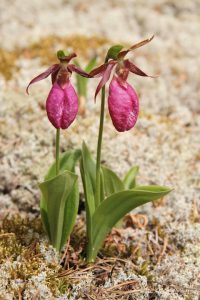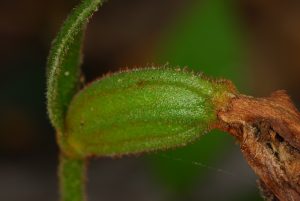Pink Lady Slipper Fact Sheet

There are four species of lady’s slippers in Maine, including the pink lady slipper, which is listed as a species of “special concern” in the Native Plant Protection Act. These orchids are showy but only grow in special habitats so collection could threaten even the more common species. Lady’s slippers have a symbiotic relationship with a fungus that provides the plant with nutrients. Because of this relationship, transplantation of pink lady slippers is rarely successful unless there is a sufficient amount of fungus available in the new area.
The pink lady slipper is a perennial monocot found throughout the eastern United States and most of Canada. It is one of the largest native Orchid species and can grow dense in small areas. Pink lady slippers can grow in wooded or semi-wooded habitats. They require acidic soil, but are tolerant to a range of shade and drainage conditions.
Leaves: Two basal leaves with parallel veins extend from the base of each plant.

Flowers: Pink lady slippers characteristically have a single pink flower. Sometimes the flowers appear as whitish-pink with dark pink venation. On rare occasions the flower is entirely white or two flowers are present. It is estimated that flowering occurs in New England between late May and mid July, although the timing has been shifting earlier in the year.
Fruit: Pink lady slippers rarely bare fruit, but when they do it is in the form of a capsule. The capsule matures from green color to tan or brown and will split open to expose the contained seeds.
Stems: A single, smooth stem supports the flower.
Sources and Additional Information:
USA Phenology Network – Observing Plants and Animals, https://www.usanpn.org/nn/Cypripedium_acaule, 21 February 2018
USDA Forest Service: Pink Lady’s Slipper (Cypripedium acaule Ait.), 21 February 2018
Lady Bird Johnson Wildflower Center, Plant Database: Cypripedium acaule, 21 February 2018
Maine Department of Agriculture, Conservation and Forestry: Maine Natural Areas Program, 21 February 2018
F.C. Seymour. (1982). The Flora of New England: a manual for the identification of all vascular plants including ferns and fern allies growing without cultivation in New England. Plainfield, N.J.: H.N. and A.L. Moldenke.
